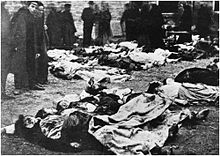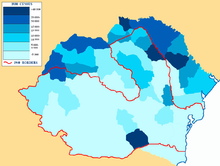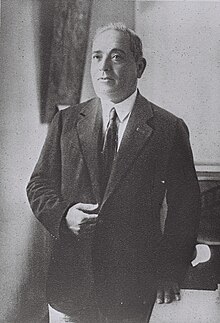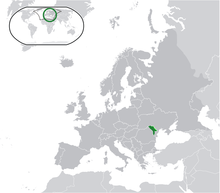|
History of the Jews in Moldova
The history of the Jews in Moldova reaches back to the 1st century BC, when Roman Jews lived in the cities of the province of Lower Moesia. Bessarabian Jews have been living in the area for some time. Between the 4th-7th centuries AD, Moldova was part of an important trading route between Asia and Europe, and bordered the Khazar Khaganate, where Judaism was the state religion.[4] Prior to the Second World War, violent antisemitic movements across the Bessarabian region badly affected the region's Jewish population. In the 1930s and '40s, under the Romanian governments of Octavian Goga and Ion Antonescu, government-directed pogroms and mass deportations led to the concentration and extermination of Jewish citizens followed, leading to the extermination of between 45,000-60,000 Jews across Bessarabia.[5][6] The total number of Romanian and Ukrainian Jews who perished in territories under Romanian administration is between 280,000 and 380,000.[5] Today, the Jewish community in Moldova has been revived and are primarily represented by the Jewish Community of the Republic of Moldova (JCM) organisation. The group was registered in its current form in 1997, but its roots stretch back to founding of the Union of Jewish Communities in Bessarabia on 3 November 1935.[7] The group estimate that the total population of Moldovan Jews in 2022 to be approx. 20,000.[8] The World Jewish Congress (of which the JCM is an affiliate member) states that there has been "a widespread development of a national self-consciousness and a return to their roots by the Jews of Moldova, with Jewish identity and culture being celebrated in a number of forms".[9] Diplomatic relations with Israel began in 1992 and the Israeli consulate is located in the capital city, Chişinău. Since 2014, Moldova has been an observer country to the International Holocaust Remembrance Alliance, and since 2019 has adopted the IHRA Working Definition of Antisemitism for official use. The Museum of Jewish History was opened in Orhei on 30 January 2023.[10] There is one Jewish kindergarten in Chişinău, two Jewish schools and a municipal Jewish library named after Itzik Manger. A Jewish newspaper, Nash Golos ("Our Voice"), is published twice a month by the Jewish Community of the Republic of Moldova.[9] There is a Jewish Cultural Center in Chişinău, as well as seven synagogues, with synagogues also present in Orhei, Soroca, and Tiraspol, and "Memorials to the Kishinev ghetto, to the Victims of Fascism, to the Victims of Chişinău Pogrom are sites for remembrance in Chişinău."[9] Other organisations include Chabad Lubavitch Moldova and Kedem. The constitution of Moldova guarantees the right to freedom of religion and the total separation of church and state, while noting the "exceptional importance" of Orthodox Christianity.[8] Holocaust denial and insulting the memory of the Holocaust are criminal offences.[8] The "production, sale, distribution, or public use of fascist, racist, or xenophobic symbols or ideology, unless used for art, science, or education. The law prohibits the promotion of xenophobia, racism, fascism, and hatred and violence on ethnic, racial, or religious grounds."[8] Since 2015, 27 January is annually recognised as the National Holocaust Remembrance Day.[9] In 2016, the Moldovan parliament endorsed the Final Report of the International Commission on the Holocaust in Romania by Elie Wiesel. Discrimination on the basis of religious affiliation is illegal, and incitement to religious and ethnic hatred was made illegal in May 2022.[8] Bessarabian JewsEarly history
Kishinev pogrom In 1903, a young Christian Orthodox boy, Mikhail Rybachenko, was found murdered in the town of Dubăsari (Dubossary), 37 km northeast of Chișinău. A Russian language antisemitic newspaper "Bessarabian", published by Pavel Krushevan, began to disseminate rumors about the murder being part of a Jewish ritual. This newspaper had been publishing rumors about the Jews that brought ruin to the local Jewish population. As for the murder, it reported that the victim visited the shop of a Jewish tobacconist before his disappearance.[13] Other anti-Semitic newspapers called for a pogrom.[14] Although the official investigation had determined the lack of any ritualism in the murder and eventually discovered that the boy had been killed by a relative (who was later found), the unrest caused by these and other rumors had resulted in a major pogrom during the Easter holidays. The pogrom lasted for three days, without the intervention of the police. Forty seven (some say 49) Jews were killed, 92 severely wounded, 500 slightly wounded and over 700 houses destroyed.[15] Many of the younger Jews, including Mendel Portugali, made an effort to defend the community. There was outcry from prominent Russian writers Leo Tolstoy and Maksim Gorky, as well as protests from Jews and non-Jews in Europe and the United States. Haim Nachman Bialik wrote about the pogrom in his poem, "The City of Slaughter", and Vladimir Korolenko in his book, House No. 13.[16] The Holocaust Up to two-thirds of Bessarabian Jews fled before the retreat of the Soviet troops. 110,033 people from Bessarabia and Bukovina (the latter included at the time the counties of Cernăuţi, Storojineţ, Rădăuţi, Suceava, Câmpulung, and Dorohoi – approximately 100,000 Jews) – all except a small minority of the Jews that did not flee in 1941 – were deported to the Transnistria Governorate, a region which was under Romanian military control during 1941–44.
 The killing squads of Einsatzgruppe D, together with special non-military units attached to the German Wehrmacht and the Romanian army were involved in many massacres in Bessarabia (over 10,000 in a single month of war, in June–July 1941), while deporting other thousands to Transnistria. From 1941 to 1942, those Jews deported to territories to distant regions of USSR and war zones on orders of Marshal Antonescu reached 56,089.[18] A huge number of this population perished during the occupation of those territories.[18] In Nazi ghettos organized in several towns, as well as in Nazi concentration camps (there was also a comparable number of Jews from Transnistria in those camps) many people died from starvation or bad sanitation, or were shot by special Nazi units right before the arrival of Soviet troops in 1944. The Romanian military administration of Transnistria kept very poor records of the people in the ghettos and camps. The only exact number found in Romanian sources is 59,392 died in the ghettos and camps from the moment those were open until mid-1943[19] This number includes all internees regardless of their origin, but does not include those that perished on the way to the camps, those that perished between mid-1943 and spring 1944, as well as those that perished in the immediate aftermath of the Romanian army's occupation of Transnistria (see for example the Odessa massacre). The Moldavian Soviet Socialist RepublicAfter World War II, the number of Jews in Moldavian Soviet Socialist Republic increased significantly, peaking at 98,001 in 1970.[20] During the 1970s Soviet Union aliyah and immigration to the West and especially in the late 1980s, many of them emigrated to Israel, United States, Canada and some to Australia and Western Europe. The last Soviet census of 1989 registered 65,672 Jews in the Soviet Republic.[21] Contemporary situation As of 2014, there are an estimated 15,000 Jews in Moldova, including over 10,000 in Chișinău alone. At the same time, there are 75,492 Moldovan Jews living in Israel, and also small communities in other parts of the world, such as Russia, the US, the UK, Germany, Romania, Australia, etc. Since 2015, 27 January is annually recognised as the National Holocaust Remembrance Day.[9] In 2016, the Moldovan parliament endorsed the Final Report of the International Commission on the Holocaust in Romania by Elie Wiesel. Discrimination on the basis of religious affiliation is illegal, and incitement to religious and ethnic hatred was made illegal in May 2022.[8] However, antisemitism is still commonplace; several churches and political organisations still refer to antisemitic rhetoric. In addition, far-right and neo-Nazi groups are active in the country. Because religion was heavily restricted in Soviet times, it is likely that there are many more people of ethnic Jewish heritage in Moldova than those who practice the religion, but many simply may not know about it. In 2024, the Action and Protection League (based in Brussels) and the European Jewish Association published a poll surveying 1,000 Moldovans. According to the results of the poll (reported by The Times of Israel), "a majority of the 923 respondents indicated that they were either neutral on Jews (27%) or associated them (35%) with “positive” qualities, including “respect, intelligent, smart, normal people, capable, ordinary, educated." The 19% percent who reported negative reactions associated Jews with such concepts as “greedy, calculating, cunning, traitors, crucifixion of Christ, bad people, foreign culture, charlatans, speculators, dirty, deceit, selfish.” Nearly half of respondents, or 48%, said they didn’t like Jews, with 13% saying they “really dislike” them, but 40% said they “really like” Jews. Compared to other ethnicities, Jews were more liked in the poll than Roma (28%), Poles (34%); immigrants (34%) and the Gagauz (39%), a Turkic ethnic group." In response to the poll, the director of the European Jewish Association lobby group, Rabbi Menachem Margolin stated that "deep-rooted antisemitism persists in Moldova. There can be no rational explanation as to why a community that represents such a tiny fraction of the overall population bears the brunt of such an alarmingly high number of stereotypes and tropes.”[22] As of December 8,2024 Rabbi Yitzchok Dovid Grossman has issued a apeal for Nosson Malul who has been imprisoned for nearly a year in Moldavia without trial[23] Notable figures
See also
References
Further reading
External links |
||||||||||||||||||||||||||||||||||||
